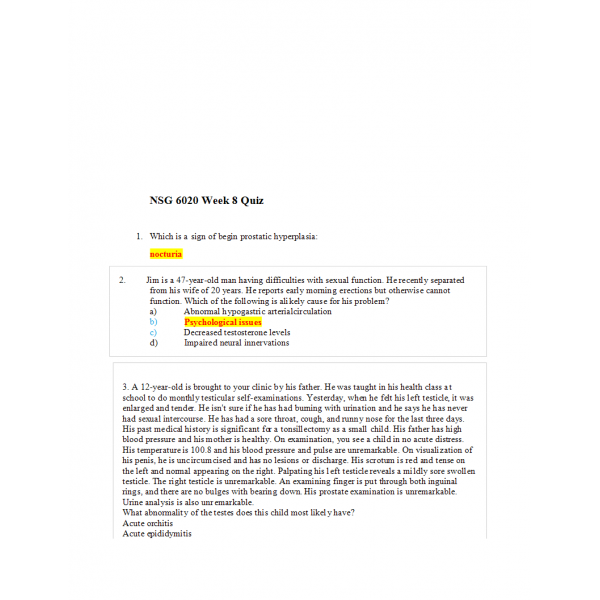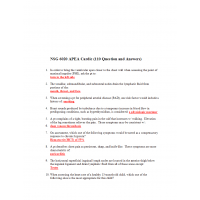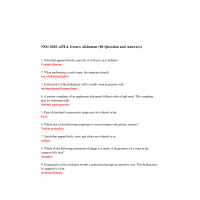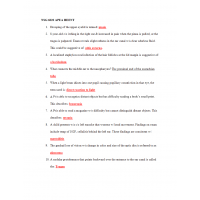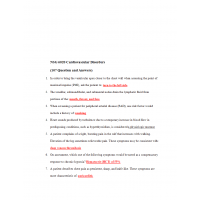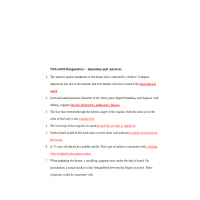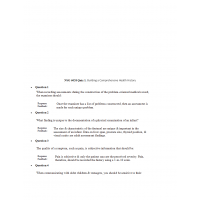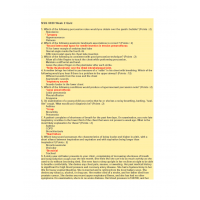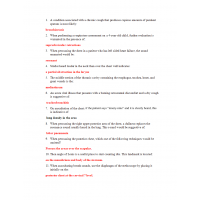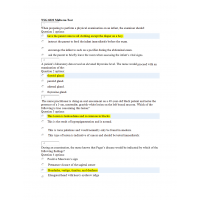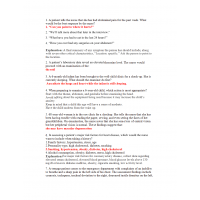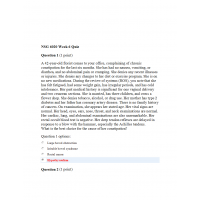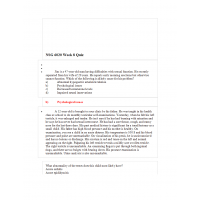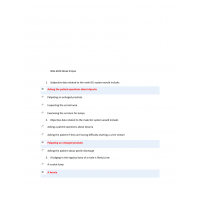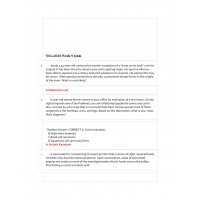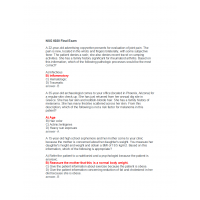NSG 6020 Week 8 Quiz 2 - Question and Answers
NSG 6020 Week 8 Quiz
1. Which is a sign of begin prostatic hyperplasia:
2. Jim is a 47-year-old man having difficulties with sexual function. He recently separated from his wife of 20 years. He reports early morning erections but otherwise cannot function. Which of the following is alikely cause for his problem?
3. A 12-year-old is brought to your clinic by his father. He was taught in his health class at school to do monthly testicular self-examinations. Yesterday, when he felt his left testicle, it was enlarged and tender. He isn't sure if he has had burning with urination and he says he has never had sexual intercourse. He has had a sore throat, cough, and runny nose for the last three days. His past medical history is significant for a tonsillectomy as a small child. His father has high blood pressure and his mother is healthy. On examination, you see a child in no acute distress. His temperature is 100.8 and his blood pressure and pulse are unremarkable. On visualization of his penis, he is uncircumcised and has no lesions or discharge. His scrotum is red and tense on the left and normal appearing on the right. Palpating his left testicle reveals a mildly sore swollen testicle. The right testicle is unremarkable. An examining finger is put through both inguinal rings, and there are no bulges with bearing down. His prostate examination is unremarkable. Urine analysis is also unremarkable.
4. Important techniques in performing the rectal examination include which of the following?
5. Which of the following conditions involves a tight prepuce which, once retracted, cannot be returned?
6. 22-year-old unemployed roofer presents to your clinic, complaining of pain in his testicle and penis. He states the pain began last night and has steadily become worse. He states it hurts when he urinates and he has not attempted intercourse since the pain began. He has tried Tylenol and Ibuprofen without improvement. He denies any fever or night sweats. His past medical history is unremarkable. He has had four previous sexual partners and has had a new partner for the last month. She is on oral contraceptives, so he has not used condoms. His parents are both in good health. On examination, you see a young man lying on his side. He appears mildly ill. His temperature is 100.2 and his blood pressure, respirations, and pulse are normal. On visualization of the penis he is circumcised, with no lesions or discharge from the meatus. Visualization of the scrotal skin appears unremarkable. Palpation of the testes shows severe tenderness at the superior pole of the normal-sized left testicle. He also has tenderness when you palpate the structures superior to the testicle through the scrotal wall. The right testicle is unremarkable. An examining finger is placed through each inguinal ring without bulges being noted with bearing down. His prostate examination is unremarkable. Urine analysis shows white blood cells and bacteria. What diagnosis of the male genitalia is most likely in this case?
6. A 60-year-old security officer comes to your clinic, complaining of a painless mass in his scrotum. He found it three days ago during a testicular self-examination. He has had no burning with urination and no pain during sexual intercourse. He denies any weight loss, weight gain, fever, or night sweats. His past medical history is notable for high blood pressure. He is married and has three healthy children. He denies using illegal drugs, smokes two to three cigars a week, and drinks six to eight alcoholic beverages per week. His mother is in good health and his father had high blood pressure and coronary artery disease. On physical examination he appears anxious but in no pain. His vital signs are unremarkable. On visualization of his penis, he is circumcised and has no lesions. His inguinal region has no lymphadenopathy. Palpation of his scrotum shows a soft cystic-like lesion measuring 2 cm over his right testicle. There is no difficulty getting a gloved finger through either inguinal ring. With weight bearing, there are no bulges. His prostate examination is unremarkable. What disorder of the scrotum does he most likely have? (
7. own Jim is a 47-year-old man having difficulties with sexual function. He recently separated from his wife of 20 years. He reports early morning erections but otherwise cannot function. What is a likely cause for his problem?
8. Induration along the ventral surface of the penis suggest which of the following:
9. A 22-year-old unemployed roofer presents to your clinic, complaining of pain in his testicle and penis. He states the pain began last night and has steadily become worse. He states it hurts when he urinates and he has not attempted intercourse since the pain began. He has tried Tylenol and ibuprofen without improvement. He denies any fever or night sweats. His past medical history is unremarkable. He has had four previous sexual partners and has had a new partner for the last month. She is on oral contraceptives so he has not used condoms. His parents are both in good health. On examination you see a young man lying on his side. He appears mildly ill. His temperature is 100.2 and his blood pressure, respirations, and pulse are normal. On visualization of the penis he is circumcised, with no lesions or discharge from the meatus. Visualization of the scrotal skin appears unremarkable. Palpation of the testes shows severe tenderness at the superior pole of the normal-sized left testicle. He also has tenderness when you palpate the structures superior to the testicle through the scrotal wall. The right testicle is unremarkable. An examining finger is placed through each inguinal ring without bulges being noted with bearing down. His prostate examination is unremarkable. Urine analysis shows white blood cells and bacteria.
9. You are examining a newborn and note that the right testicle is not in the scrotum:
10. Which of the following clinical findings can mimic a case of testicular torsion but not considered an emergent condition:
11. A 50-year-old truck driver comes to your clinic for a work physical. He has had no upper respiratory, cardiac, pulmonary, gastrointestinal, urinary, or musculoskeletal system complaints. His past medical history is significant for mild arthritis and prior knee surgery in college. He is married and just changed jobs, working for a different trucking company. He smokes one pack of cigarettes a day, drinks less than six beers a week, and denies using any illegal drugs. His mother has high blood pressure and arthritis and his father died of lung cancer in his 60s. On examination, his blood pressure is 130/80 and his pulse is 80. His cardiac, lung, and abdominal examinations are normal. He has no inguinal hernia, but on his digital rectal examination you palpate a soft, smooth, nontender pedunculated mass on the posterior wall of the rectum..
12. A 15-year-old high school football player is brought to your office by his mother. He is complaining of severe testicular pain since exactly 8:00 this morning. He denies any sexual activity and states that he hurts so bad he can't even urinate. He is nauseated and is throwing up. He denies any recent illness or fever. His past medical history is unremarkable. He denies any tobacco, alcohol, or drug use. His parents are both in good health. On examination you see a young teenager lying on the bed with an emesis basin. He is very uncomfortable and keeps shifting his position. His blood pressure is 150/100, his pulse is 110, and his respirations are 24. On visualization of the penis he is circumcised and there are no lesions and no discharge from the meatus. His scrotal skin is tense and red. Palpation of the left testicle causes severe pain and the patient begins to cry. His prostate examination is unremarkable. His cremasteric reflex is absent on the left but is normal on the right. By catheter you get a urine sample and the analysis is unremarkable. You send the boy with his mother to the emergency room for further workup.
What is the most likely diagnosis for this young man's symptoms?
13. Which of the following conditions involves a tight prepuce:
| Institution & Term/Date | |
| Term/Date | South University |
-
$10.00

